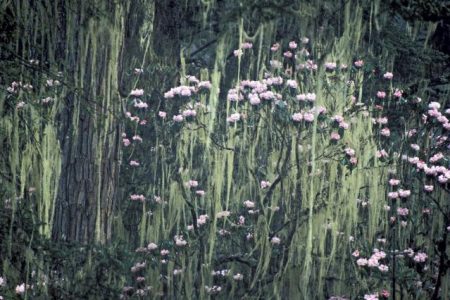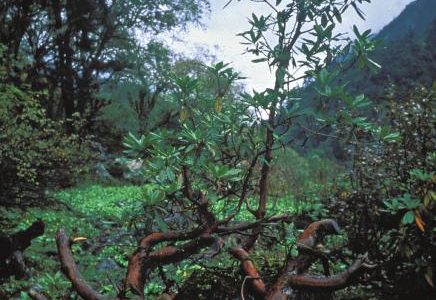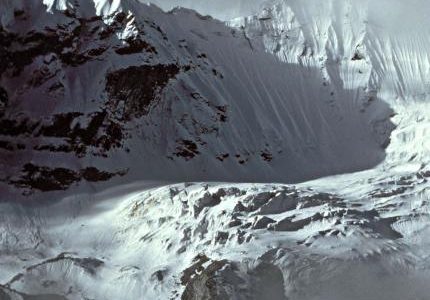Yak Caravan Entering Everest’s Hidden Eastern Valley – Historical Entries by Outsiders Described Below
In terms of history, let’s address the traditional name of what the world calls “Mount Everest.” The Tibetan people call this mountain “Qomolangma” –and that name comes because they noticed something special. Among all the mountains that they knew, this one usually wore a “white scarf.” Thus, the Tibetans have an ancient custom of giving each other white scarfs as a sign of respect; their name for this is “kata.” So they named this mountain Qomolangma, “Goddess Mother of the Wind.”
When you see the almost constant snow plume off her summit (the top of Qomolangma is the only part of Earth that reliably towers into the jet stream), the signs are pretty strong that this mountain stands among the great winds of the world.
The British realized that this mountain was also the highest in the world – although both the Chinese and Nepal sides of the mountain were closed to foreigners. So they sent in spies to investigate, and one of the first was led by Captain Noel who described his approach:
“I decided in 1913 to seek out the passes that led to Everest and if possible to come to close quarters with the mountain… to follow down the Tashirak Valley to reach the Kama Valley and then to go up this valley to Mount Everest. The maps were entirely wrong. This mountain range stood between me and Mount Everest…
I was fired on by that grotesque instrument! It made enough noise for a canon. Where the slugs went I could never tell-all over the place, I think. I slipped behind the ruins of the Tibetan wall. I placed a shot from my American rifle over his head, and he went off so fast… There was nothing to be done but to turn our backs on the approaches of Everest, within forty miles, and nearer at that time than any white man had been.”
Capt J.B.L. Noel, Through Tibet to Everest (1927)
Then in 1921 the first serious mountaineering expedition approached the mountain, led by Col. Howard-Bury, and had as one of its members, the famous George-Leigh Mallory (who would subsequently disappear approaching the summit in 1924).
“We had not been able to gather much information locally about Mount Everest. A few of the shepherds said that they had heard that there was a great mountain in the next valley to the South… They called this valley the Kama Valley, and little did we realize at the time that in it we were going to find one of the most beautiful valleys in the world.”
Col. Howard-Bury, Reconnaissance of Everest (1921)
“It was a fortunate matter that he (Mallory) was led into the Kama Valley, for it must be the most beautiful valley in the whole Himalaya… The beauty of the Kama Valley lay in this, that it came straight down from Mount Everest which filled in all the upper part; that it ran directly under the mighty cliffs of Makalu, a mountain even more beautiful than Everest.”
Sir Francis Younghusband, The Epic of Mount Everest (1926)
- 1921 – A party under Lieutenant Colonel C.K. Howard-Bury set out to explore the Himalayan range and find a route up Everest. The expedition was sponsored by two British exploring organizations, The Royal Geographical Society and the Alpine Club. Other members included G.H. Bullock and George Mallory, whose famous answer for why he wanted to climb Everest was, “Because it’s there.” These were the first Westerners to witness the beauty of the Gama Valley.
- 1922 – Brigadier General C.G. Bruce led an attempt at summiting Everest that was cut short by early monsoon snows and an avalanche which took the lives of seven Sherpas. Among others in their party were Mallory, and Captain C.J. Morris. On their way back to India, they made a side trek into the Arun and Gama Valleys.
- 1988 – Heavy Hands on the Land, National Geographic – When our team’s leadership began creating the Qomolangma (Everest) National Nature Preserve, many threats confronted Everest’s ecology: snow leopards and musk deer being killed, garbage from tourists and climbers, and forests felled. The article linked above from National Geographic Magazine (November 1988) describes the deforestation danger to the Gama Valley (spelled in this article Kama). Then, timbers were being carried out on people’s backs – but the article notes a road for trucks was also under construction. All has stopped now. Snow leopard recovery worldwide began here; timbering has ended. The Gama Valley is now under conservation management – protected, along with its rich forests, flowers, and the world’s 1st, 4th, and 5th highest mountains, as arguably “the most beautiful valley in the world.”










